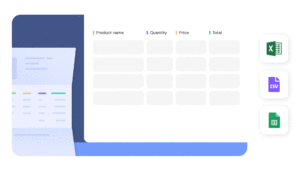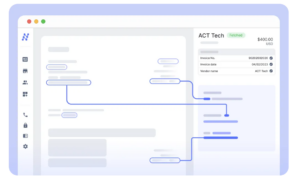
Accounts Payable (AP) processes are an important function for every business, overseeing the outgoing payments to suppliers and vendors. Traditionally tackled through manual processes, digital transformation is now at the forefront of AP, with technologies like AI and ML revolutionizing how businesses manage their finances.
In an era where digital transformation is reshaping every aspect of business operations, the role of Accounts Payable (AP) is also undergoing a significant evolution. The worldwide AP automation market is forecasted to grow from US$2.6 billion in 2021 to USD 7.5 billion by 2030 at a CAGR of 12.5%.
This transformation is not just a trend; it’s an indicator for businesses aiming to stay competitive, reduce costs, and enhance operational efficiency that the solution lies in AP automation and transformation. In this article, we delve into the nuances of AP transformation, and how it is a strategic move in financial operations that helps businesses stay competitive in a constantly evolving economic landscape.
What is Digital Transformation in Accounts Payable?
Digital transformation in AP is the integration of advanced technologies like machine learning (ML), artificial intelligence (AI), and robotic process automation (RPA) in the process to stream and automate back-office processes. This transformation eliminates reliance on manual workflows, significantly enhancing efficiency and reducing the risk of fraud and errors. As more CFOs and financial management teams adopt AP digital transformation, they find their systems becoming smarter, saving time and money while improving financial controls and compliance with global regulations.
Importance of Digital Transformation in Accounts Payable
The importance of digital transformation in Accounts Payable (AP) transcends mere technology adoption. It represents a fundamental shift in how businesses manage their financial operations. In an era marked by rapid technological advancements, digitizing AP processes is essential for organizations to stay abreast of these changes and remain competitive.
Traditional, manual methods for AP processing are not only time-consuming but also prone to errors and inefficiencies. Digitization in AP not only streamlines workflows, but also enhances visibility into the process across the organization. It enables more control over financial transactions, leading to more informed decision-making.
This is crucial in a business landscape characterized by rising inflation and workforce shortages, factors that were particularly highlighted during the COVID-19 pandemic. The pandemic underscored the need for flexibility and adaptability in business operations, and digitally advanced AP departments are able to navigate modern remote-working environments and transitions more smoothly.
Importantly, digital AP systems enable businesses to harness the power of data analytics, providing critical insights into spending patterns, vendor performance, and opportunities for cost savings. This level of analysis is impossible with traditional AP methods, underscoring the strategic value of digital transformation in this field. In essence, digitizing AP is not just a technological upgrade but a strategic investment that empowers businesses to be more agile, resilient, and financially astute in an ever-changing economic landscape.
Benefits of AP Automation
By adopting modernAP automation tools, organizations position themselves to keep pace with digitization and continually improve their functioning over time, regardless of where they currently are in their digitization and AP journey.
- Enhanced Efficiency and Accuracy: AP automation reduces manual data entry, minimizing human errors and thus reducing the time spent entering and error-checking information. This leads to more accurate data handling and efficient processing of invoices.
- Time and Cost Savings: By automating invoice capture and digital payments, organizations save significant time and resources. This efficiency also extends to handling increased invoice volumes without additional staffing needs. The organization thus has freed-up resources to tackle more value-additive tasks.
- Improved Scalability: As a business grows, the volume of invoices and complexity of financial transactions increase. AP automation allows companies to scale their operations seamlessly. With the ability to handle a larger number of invoices efficiently, businesses can grow without proportionally increasing their AP staff, thereby maintaining a lean and efficient operation.
- Optimized Cash Flow Management: AP automation offers more control over payment timings and methods. By scheduling payments strategically, companies can better manage their cash flow. The use of electronic payment methods like virtual cards and automated payment scheduling also helps avoid late payments. This allows businesses to take advantage of early payment discounts, optimizing the overall financial health of the business.
- Improved Supplier Relationships: Automated AP processes lead to more timely and accurate payments, enhancing supplier trust and satisfaction. With features like electronic invoicing and streamlined payment processes, suppliers experience fewer delays and errors, strengthening the business-supplier relationship. AP software enables businesses to store supplier preferences and currencies, ensuring the payment process is smooth and fair.
- Greater Visibility and Control: AP automation provides real-time visibility into the AP process, from invoice receipt to payment. This transparency allows for better tracking, auditing, and financial planning. Managers can monitor AP processes more effectively, identify bottlenecks, and make data-driven decisions.
- Fraud Prevention and Compliance: Automated systems are equipped to identify discrepancies like duplicate invoices or unusual payment patterns, enhancing fraud prevention. Additionally, these systems help maintain compliance with various financial regulations by ensuring accurate and timely record-keeping.
- Data Analytics and Reporting: AP automation tools often come with advanced analytics capabilities. They can generate valuable reports and metrics, offering insights into spending patterns, vendor performance, and potential areas for cost savings. This data is crucial for strategic financial planning and decision-making.
- Environmental Benefits: Moving away from paper-based processes to digital solutions contributes to an organization’s sustainability goals. This reduction in paper usage not only helps the environment but also decreases storage and handling costs associated with physical documents.
In summary, AP automation transforms the accounts payable process into a more efficient, cost-effective, and strategic function, crucial for businesses aiming to thrive in today’s fast-paced and competitive economic environment.
Which AP Functions Can Be Automated?
Digital transformation within the AP process can, and should, be multi-faced. Here are some of the several functions that can be automated:
- Supplier Onboarding and Tax Compliance: Automation streamlines the supplier onboarding process, ensuring that all necessary data, including tax information, is accurately collected and managed. This includes automated checks for tax compliance and other regulatory requirements.
- Supplier Invoice Data Capture: AP automation employs technologies like OCR to automatically capture and categorize data from supplier invoices, significantly reducing manual entry.
- Invoice Processing: This includes automating the entire workflow of invoice processing from receipt to posting. Automation ensures that invoices are processed efficiently, following pre-set rules for approvals and exceptions.
- Matching Processes: Automation aids in 2-way and 3-way matching by comparing invoices with purchase orders and delivery receipts, ensuring tracking and accuracy of payments and also preventing overpayments.
- Invoice Approval: Automated workflows route invoices to the appropriate personnel for approval, based on predefined rules, ensuring timely and efficient invoice processing.
- Expense Management: Automation helps in categorizing and tracking expenses against budgets, improving the visibility and management of expenditure.
- Global Payments: AP automation solutions facilitate seamless global payments, managing different currencies and compliance with international payment regulations.
- Payments Reconciliation: Automated systems reconcile payments with bank statements, ensuring all transactions are accurately recorded and accounted for.
- Invoice Payment Status Monitoring: AP systems track the status of each invoice payment, providing real-time visibility into the AP process.
- Generating Metrics and KPI Trends: Automation tools provide analytics and reporting capabilities, generating insights into AP performance, vendor management, and financial planning.
Accounts Payable Steps Which Can Be Automated
As with functions with the AP process, individual steps of the AP process can also be automated. Here’s how:
- Receipt, Capture, and Coding of Invoices: Automation tools capture and classify invoice data upon receipt, reducing manual handling and potential for error.
- Purchase Order (PO) Matching: Intermediate AP systems automate the matching of invoices to corresponding POs, ensuring that payments are made against verified purchases.
- Three-Way Matching: This involves matching invoices, POs, and delivery receipts to confirm that orders have been fulfilled correctly before payment is made.
- Facilitating Communication: Advanced systems bridge the gap between the AP team and other departments, allowing for collaborative invoice processing and decision-making.
- End-to-End Automation: The most sophisticated AP systems offer comprehensive automation, handling every step from invoice capture to payment processing. They provide flexibility in payment methods and simplify reconciliation, making the entire AP process efficient and user-friendly.
Conclusion
The transformation of Accounts Payable through automation is not just a trend, but a fundamental shift in financial management for businesses who want to stay competitive in an ever-evolving work landscape. By embracing AP automation, businesses enhance efficiency, accuracy, and scalability, while also achieving cost savings and improved supplier relationships.
This shift towards digitalization in AP processes equips organizations with the ability and tools to navigate the complexities of modern finance, fostering better decision-making, relationships, and strategic planning. As the world moves rapidly towards a digital-first approach, the role of AP automation becomes increasingly important, positioning adaptable businesses for success.
- SEO Powered Content & PR Distribution. Get Amplified Today.
- PlatoData.Network Vertical Generative Ai. Empower Yourself. Access Here.
- PlatoAiStream. Web3 Intelligence. Knowledge Amplified. Access Here.
- PlatoESG. Carbon, CleanTech, Energy, Environment, Solar, Waste Management. Access Here.
- PlatoHealth. Biotech and Clinical Trials Intelligence. Access Here.
- Source: https://nanonets.com/blog/ap-transformation/
- :has
- :is
- :not
- :where
- 12
- 2021
- 2030
- 7
- a
- ability
- Able
- accounted
- Accounts
- accounts payable
- accuracy
- accurate
- accurately
- achieving
- across
- Additional
- Additionally
- adopt
- Adopting
- Adoption
- advanced
- advancements
- ADvantage
- against
- agile
- AI
- aids
- Aiming
- All
- All Transactions
- Allowing
- allows
- also
- an
- analysis
- analytics
- and
- ap automation
- approach
- appropriate
- approval
- approvals
- ARE
- areas
- article
- artificial
- artificial intelligence
- Artificial intelligence (AI)
- AS
- aspect
- associated
- At
- auditing
- automate
- Automated
- automatically
- automating
- Automation
- avoid
- away
- Bank
- based
- BE
- becomes
- becoming
- been
- before
- Better
- between
- Billion
- bottlenecks
- BRIDGE
- Budgets
- business
- businesses
- but
- by
- cagr
- CAN
- capabilities
- capture
- Cards
- Cash
- cash flow
- categorizing
- CFOs
- Changes
- characterized
- Checks
- Classify
- Coding
- collaborative
- come
- Companies
- comparing
- competitive
- complete
- complexities
- complexity
- compliance
- comprehensive
- conclusion
- Confirm
- constantly
- continually
- contributes
- control
- controls
- correctly
- Corresponding
- Cost
- cost savings
- cost-effective
- Costs
- COVID-19
- COVID-19 pandemic
- critical
- crucial
- currencies
- Currently
- data
- Data Analytics
- data entry
- data-driven
- Decision Making
- decisions
- decreases
- delays
- delivery
- delve
- departments
- different
- digital
- Digital Payments
- Digital Transformation
- digitalization
- digitally
- digitization
- digitizing
- discounts
- documents
- during
- each
- Early
- Economic
- effectively
- efficiency
- efficient
- efficiently
- Electronic
- electronic payment
- eliminates
- embracing
- employs
- empowers
- enable
- enables
- enhance
- Enhances
- enhancing
- ensures
- ensuring
- entering
- Entire
- entry
- Environment
- environments
- equipped
- Era
- error
- Errors
- essence
- essential
- ever-changing
- Every
- evolution
- evolving
- expenses
- experience
- extends
- facilitate
- factors
- fair
- fast-paced
- Features
- fewer
- field
- finance
- Finances
- financial
- financial planning
- financially
- Find
- Flexibility
- flow
- following
- For
- forefront
- fostering
- fraud
- FRAUD PREVENTION
- from
- function
- functioning
- functions
- fundamental
- gap
- generate
- generating
- Global
- Global Payments
- Goals
- Grow
- Grows
- guide
- handle
- Handling
- harness
- Have
- Health
- help
- helps
- here
- Highlighted
- How
- HTTPS
- human
- identify
- importance
- important
- impossible
- improve
- improved
- improving
- in
- includes
- Including
- Increase
- increased
- increasing
- increasingly
- Indicator
- individual
- inefficiencies
- inflation
- information
- informed
- insights
- integration
- Intelligence
- International
- into
- investment
- invoice
- invoice processing
- invoices
- invoicing
- IT
- journey
- just
- Keep
- landscape
- larger
- Late
- lead
- leading
- Leads
- learning
- Level
- lies
- like
- machine
- machine learning
- made
- maintain
- Maintaining
- make
- Making
- manage
- managed
- management
- Managers
- managing
- manual
- marked
- matching
- mere
- methods
- Metrics
- minimizing
- ML
- Modern
- money
- Monitor
- more
- more efficient
- most
- move
- moves
- moving
- Navigate
- necessary
- Need
- needs
- now
- nuances
- number
- OCR
- of
- offer
- offering
- Offers
- often
- on
- Onboarding
- only
- operation
- operational
- Operations
- opportunities
- optimizing
- or
- order
- orders
- organization
- organizations
- Other
- over
- overall
- overseeing
- Pace
- pandemic
- Paper
- paper-based
- particularly
- patterns
- payment
- payment methods
- payment processing
- payments
- performance
- Personnel
- physical
- planning
- plato
- Plato Data Intelligence
- PlatoData
- PO
- PoS
- position
- positioning
- potential
- power
- preferences
- preventing
- Prevention
- process
- Process Automation
- Processed
- processes
- processing
- provide
- provides
- providing
- purchase
- purchases
- rapid
- rapidly
- real-time
- receipts
- reconciliation
- record-keeping
- recorded
- reduce
- reduces
- reducing
- reduction
- Regardless
- regulations
- regulatory
- relationship
- Relationships
- reliance
- remain
- Reporting
- Reports
- represents
- Requirements
- reshaping
- resilient
- Resources
- Revolutionizing
- rising
- Risk
- Robotic Process Automation
- Role
- Route
- rpa
- rules
- s
- satisfaction
- Save
- saving
- Savings
- Scalability
- Scale
- scheduling
- seamless
- seamlessly
- several
- shift
- shortages
- should
- significant
- significantly
- simplify
- smarter
- smooth
- smoothly
- Software
- solution
- Solutions
- some
- sophisticated
- Spending
- spent
- Staff
- staffing
- statements
- Status
- stay
- Step
- Steps
- storage
- store
- Strategic
- STRATEGIC INVESTMENT
- Strategically
- stream
- streamlined
- strengthening
- success
- SUMMARY
- supplier
- suppliers
- Sustainability
- Systems
- tackle
- Take
- tasks
- tax
- team
- teams
- technological
- Technologies
- Technology
- that
- The
- the world
- their
- themselves
- thereby
- These
- they
- this
- Thrive
- Through
- Thus
- time
- time-consuming
- timely
- timings
- to
- today’s
- tools
- towards
- track
- Tracking
- traditional
- traditionally
- Transactions
- transcends
- Transformation
- transforms
- transitions
- Transparency
- Trend
- Trust
- undergoing
- Unsplash
- upgrade
- upon
- Usage
- USD
- use
- user-friendly
- Valuable
- value
- various
- vendor
- vendors
- verified
- Virtual
- virtual cards
- visibility
- volume
- volumes
- want
- we
- were
- which
- while
- WHO
- with
- within
- without
- Work
- workflow
- workflows
- Workforce
- world
- worldwide
- zephyrnet











